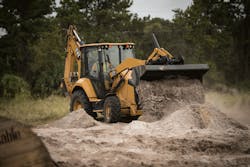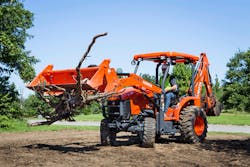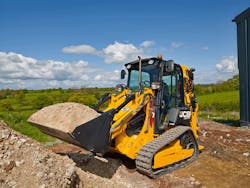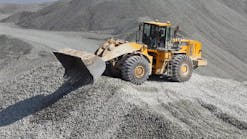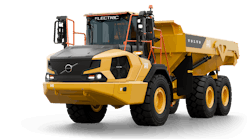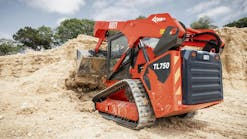“Managers should be closely monitoring their fleets with telematics to verify how much idle time is being put on their machines,” says Ed Brenton, product manager, Case backhoe loaders. “Turning off a machine, even for a short amount of time, can help reduce unnecessary fuel/fluid costs and wear on engine components. It may also give them an idea of how hard the machine is working throughout the day, which could clue them in to whether or not they need a bigger or smaller machine on the job site, or perhaps change how their job site is set up.
“For example, if they’re noticing a lot of excessive roading on their job sites, they may benefit from moving their stockpiles closer to where they’re being utilized,” Brenton says.
A number of backhoe loader manufacturers offer managers features specifically designed to help them control fuel burn.
“Outside of labor, typically the largest operating cost is fuel,” says Brian Hennings, product marketing manager, Deere backhoe loaders. “A basic fuel-saving tip includes keeping idle time at a minimum by shutting off engines when possible. Backhoes have been observed running extended idle in between job site tasks, or for HVAC needs. Minimizing engine run time also helps keep warranty hours low and improves residual values over time.”
Hennings says choosing a backhoe loader with auto idle can help.
“Auto idle reduces engine speed when rear backhoe hydraulics aren’t in use, and auto shutdown turns off the engine after an operator-selected period of inactivity,” he says.
“Also, with pressure-compensated load-sensing hydraulics (PCLS), operators can dial engine rpm back during trenching applications with minimal impact to productivity and multifunctioning,” Hennings says. “PCLS hydraulics are offered as a standard configuration on 310SL HL, 410L, and 710L Deere backhoes.”
At Conexpo 2020, Caterpillar unveiled a new line of Cat backhoe loaders, with fuel savings being one of the hallmarks. “Our 415 to 430 models have a new Cat C3.6 engine that offers 10 percent or more fuel savings over our previous generation of backhoes,” says Dustin Adams, product application specialist for Caterpillar backhoe loaders.
“Managers should also look for equipment that can help them save time by maximizing the productivity of the operator,” says Joshua Wells, product manager for JCB backhoe loaders, Access, and LiveLink. “JCB’s 3CX and 4CX Super backhoes have an ergonomic cab and control layout that provides comfort to the operator, minimizing fatigue, and allowing them to work more productively.
“Additionally, they have other cost-saving features such as AutoIdle to save fuel, AutoCheck that performs the daily checks for the operator to save time, and other features that allow the operator to work more efficiently and cut costs,” Wells says.
How to maintain backhoe loaders
Daily maintenance checks, of course, are key for avoiding downtime and unplanned costs. Patrick Baker, CE product manager for Kubota backhoe loaders, details some help his company provides for operators.
“Preventative maintenance is a huge part of keeping a piece of equipment in peak working condition,” Baker says. “The L47 and M62 come standard with the IntelliPanel, which is an LCD panel that provides indicators, displays, and sensor messages notifying the operator of working status, engine conditions, fuel and oil warning signals, and a variety of maintenance indicators.
“The IntelliPanel helps the operator keep the backhoe in working condition,” Baker says. “It also notifies the operator when it’s time to refuel or perform maintenance.”
Brenton sums up the maintenance discussion. “Anything managers can do to help keep their machines up and running will always put money in their pockets, even if it means spending a little money up-front on repairs,” he says.
Managers can do themselves, and their operators, a favor by shopping around for machines with features that enhance operator comfort and, therefore, productivity.
Some of the latest enhancements come from the new Cat line.
“Seat-mounted controls have been introduced in the 420 XE, improving operator ergonomics and reducing operator fatigue for those long work days,” Adams says. “Programmable loader and backhoe controls can be tuned to the operating preference or skillset of your operator, reducing the learning curve and increasing efficiency.”
Adams says the 420 and 420 XE have a 15-percent Boom Lift improvement. “Machine utilization has been increased with the introduction a Single Tilt IT Loader Coupler available for all Cat models, allowing the operator to perform more than just load and carry,” Adams says. “From attaching a Cat broom and sweeping streets to pushing snow, these new backhoe loaders won’t sit still on the job site.”
Case also made a big splash at Conexpo in March with its all-electric lithium-ion battery-powered 580 EV backhoe loader.
Backhoe loaders on tracks
In 2004, Case showed the Conexpo crowd in Las Vegas a shell of a backhoe loader with a quad track system replacing the four wheels, but the concept was never close to being developed for market. Now, JCB’s tracked compact backhoe loader has brought the basic idea to life. JCB says it is doing well.
“Despite the pandemic, we have seen great demand for our 1CXT, our tracked compact backhoe loader,” Wells says. “As the market demand moves towards compact equipment, JCB has answered with an industry exclusive construction-grade, tracked backhoe loader that is able to work in tight areas due to its small working footprint, without any compromise on performance.
“The 1CXT fills the needs of contractors and landscapers that need smaller equipment to work in tight areas, and helps them avoid the need to use multiple pieces of equipment to complete the job,” according to Wells.
Coronavirus affects backhoe loader market
“According to the most recent AEM data, the backhoe market is down 35 percent as compared to 2019,” Case’s Brenton says. “This is primarily attributed to the economic uncertainty brought on by the Covid-19 pandemic. Rental markets were hit the hardest by far, showing numbers that are down over 60 percent, year-to-date.
“In general, if you need a backhoe, or if your budget was already put in place to replace a machine, those activities are still taking place,” Brenton says. “All other major equipment investments seem to be slowed for now.”
Deere’s Hennings seems to borrow from his company’s earnings statements as he assesses the backhoe loader market.
“The U.S. and Canadian backhoe market has seen some strong head winds so far in 2020,” he says. “Similar to other construction-related areas, new backhoe sales had slowed with the uncertainty of the duration and economic impact of the Covid-19 pandemic.”
Cat’s Adams, however, is more optimistic.
“We have experienced market improvement year over year and anticipate that to continue,” he says. “We’re confident that the industry is healthy, and we are well positioned to continue to meet market demand with new products to support our dealers and customers.”
Kubota says it has seen market-share growth.
“We continue to see growth in market share due to a number of industry factors,” Baker says. “Kubota has seen significant growth in the rental market from both large and small rental fleet companies, where a novice ‘weekend warrior’ can rent a backhoe to complete projects around the house.”
